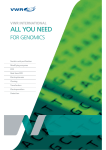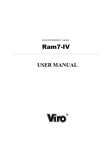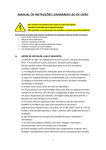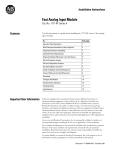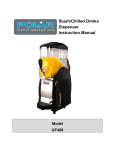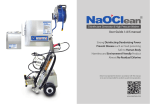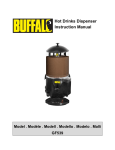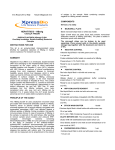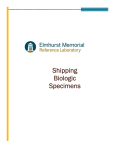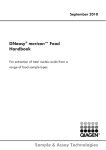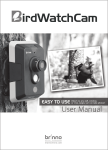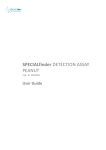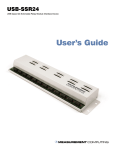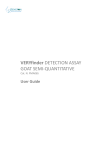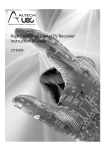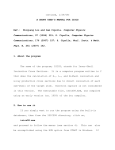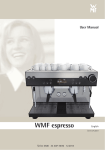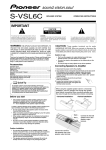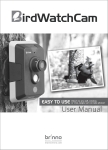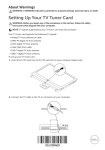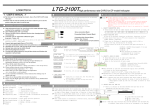Download Datasheet - Innosieve
Transcript
QuickBlue Campylobacter jejuni Real-Time PCR DNA Detection Kit User manual www.QuickBlue.de For food testing only QuickBlue Index Page Substances QB-RT01-50 QB-RT01-250 QB-RT01-1000 Substances 2 50 Additional required material 2 QuickBlue DNA Detection Kit Components for 25 µl reaction 250 1000 Storage 2 Overview PCR detection 3 Specifications 4 Product limitations 4 Introduction 5 1. PCR premaster (white) contains: •RNase free water • PCR buffer • MgCl2 (1,5 mM) • dNTP-Mix including dUTP • primer pair • HotMaster Taq polymerase 1 Cup 5 Cups 10 Cups Protocol 5 Mastermix preparation 6 2. UracilGlycosylase (UNG) (yellow) 1 Cup 1 Cup 1 Cup Prearrangement 6 PCR program 6 3. TaqMan probe (green) 1 Cup 1 Cup 1 Cup Pipetting of PCR mastermix and DNA samples 7 4. Reference DNA (positive control) (red) 1 Cup 1 Cup 1 Cup Thermocycling 7 PCR results 5. RNase free water (blue) 1 Cup 2 Cups 5 Cups 9 Trouble shooting 10 6. User manual 1 1 1 Additional required material: Instrumentation and media for preculture (if necessary), equipment for water-filtration (if necessary), PBS buffer, DNA extraction kits, Instruments for PCR (Realtime cycler). Storage: The QuickBlue DNA Detection PCR Kit should be stored at - 20 °C , short storage at + 5 °C is possible. After thawing the Premaster shall be stored at +4°C! Correct storage and handling increases the stability of the PCR kit! www.QuickBlue.de 2 QuickBlue Overview PCR detection: If applicable: preculture (A) / water-filtration (B) Bacteria DNA preparation (A) Pre-enrichment of sample in an appropriate (selective) medium (1:10 w/v: 25 g sample + 225 ml medium) for 2024 hours at appropriate temperature. (B) Filtration of 100 ml with an appropriate filter system* (0,45 µm!), e.g. cellulose nitrate filter. (A) Use QuickBlue DNA purification kit or other appropriate DNA purification methods. Thermal lysis may only be used in matrices which does not contain components inhibiting the PCR reaction. QuickBlue-Kit bacteria: (A) after DNA preparation dilute DNA 1:10 in TE buffer to avoid PCR inhibition. DNA purification Mastermix preparation PCR pipetting (B) extract DNA from the filter directly (e.g. with CTAB lysis buffer*); eucaryota: use a commercial DNA purification kit* like column systems or CTAB extraction. combine premaster (white), TaqMan probe (green) and UNG (yellow), amounts see table 3 (page 9), mix well (= Mastermix). Pipetting: 24 µl Mastermix and 1 µl DNA or 1 µl H2O (= negative control, blue) or 1 µl reference DNA (= positive control, red) Initialphase: 45 cyles: Thermocycling End phase: 2 min 20 s 30 s 20 s hold 50 °C, 1 min 95 °C, 95 °C, 60 °C, 72 °C 10 °C 3 www.QuickBlue.de * not included in the PCR kit QuickBlue Specifications Specificity Campylobacter jejuni The primer and probe systems are species specific for the respective QuickBlue PCR DNA Detection Kits. Sensitivity After pre-enrichment < 1 cells / 25 g Without pre-enrichment < 10 cells / g or 10 non-degraded genomes Technical support The Q-Bioanalytic GmbH offers a qualified technical support. If you have questions or problems with the handling of the PCR detection kit, do not hesitate to contact us. For our technical support and more information about our QuickBlue PCR Detection Kit please call phone.: +49 - (0)471 - 48 32 440. Product limitations QuickBlue DNA Detection Kit is licensed for food testing only. Safety information When working with the QuickBlue DNA PCR Detection Kit, protective clothing should be worn as well as lab gloves. Work should be done under PCR-sterile conditions. Avoid contact with DNA or DNA contaminated areas and surfaces during PCR mastermix preparation. First pipette the mastermix and subsequently the DNA into the PCR tubes or PCR plates. www.QuickBlue.de 4 QuickBlue Introduction Target organisms will be detected with species specific oligonucleotides (specific primer from German LFGB § 64 or NCBI database entries). High specificity and sensitivity of the PCR kit result from chosen PCR components as well as special Taq-Enzyme and PCR buffer. The QuickBlue DNA Detection PCR Kit was optimized on several thermocyclers. The user manual contains a general protocol for this PCR application. Kits were validated with Roche LightCycler 480, Applied Biosystems StepOne, Stratagene MX 4000 and Eppendorf RealPlex Cyclers. Protocol After appropriate pre-enrichment and/or DNA preparation perform the following steps for the PCR: • Preparation of mastermix • Pipetting the samples and controls • Thermocycling • Evaluation Important advices for mastermix preparation • Start the PCR only with the PCR program as shown in table 1 (page 6) • Components are optimized for a volume of 25 µl • Pipette always 1 µl of your DNA sample to the specific mastermix to a total volume of 25 µl • Use only declared PCR tubes and PCR plates (from polyethylen, polypropylene or polycarbonate, no polystyrene!!!) for this PCR kit. www.QuickBlue.de 5 QuickBlue Mastermix preparation Prearrangement The PCR components have to thaw in a sterile, DNA-free and PCR product free area ( separate PCR room or PCR hood). Place the pipettes, tips and waste container closely to your workbench so you could not touch other objects with your disposable lab gloves during pipetting. This is to avoid contaminations of your PCR components. Set the PCR tubes/plate and the DNA samples in a separate laboratory or aside the PCR hood. PCR program Before pipetting make sure that following PCR program is on your thermocycler: Table 1: Demonstration of the specific PCR program PCR steps Time Temperature Commentary UNG activity Initial denaturation 2 min 1 min 50 °C 95 °C eliminates contaminations activates HotStart enzyme Number of cycles x 45 defines product amount Denaturation 20 s 95 °C denaturation of dsDNA Primer annealing 30 s 60 °C primer annealing on ssDNA, fluorescence measurement (6-Fam filter system, 483 nm) Elongation 20 s 72 °C primer extension to PCR product storage hold 10 °C storage temperature www.QuickBlue.de 6 QuickBlue Pipetting the PCR mastermix and DNA samples Table 2: Demonstration of the composition (per PCR reaction) Components RT-PCR premaster (white) RNase free water (blue) Volume / reaction 12,5 µl 11,0 µl End concentration - UNG (yellow) Probe (green) Mix volume DNA Total volume 0,2 µl 1,0 µl 24,7 µl 1,0 µl 25,7 µl 0,2 Unit variable - 1. Depending on your total PCR amount pipette the adequate volumes of premaster, water, Uracil-Glycosylase (UNG) and probe in a sterile PCR tube (e.g.: 1,5-ml reaction cup). 2. Mix the mastermix on a shaker, to disperse components homogeneously. 3. Put the PCR components back into the freezer (at - 20 °C). 4. Aliquot 24 µl of your mastermix into the labeled PCR tubes (0,2 ml tubes, 8module-strips, or 96/384-PCR-plate). Don’t forget controls! 5. Pipette 1 µl of your sample DNA per cavity into the mastermix. This avoids crosscontaminations! 6. Don’t forget to pipette 1 µl of the negative control (blue cup) and 1 µl of the positive control (red cup) into separate PCR mastermixes. Include a positive control reaction in your DNA preparation to exclude effects of inhibition by the matrix analysed. 7. Close the tubes or plates well and put them into the thermocycler. Thermocycling Start the specific PCR program (see table 1, page 6). www.QuickBlue.de 7 QuickBlue Table 3: Preparation of premaster for parallel approaches: Number: H2O: 1 11 2 22 3 33 4 44 5 55 6 66 7 77 8 88 9 99 10 110 11 121 12 132 13 143 14 154 15 165 16 176 17 187 18 198 19 209 20 220 21 231 22 242 23 253 24 264 25 275 26 286 27 297 28 308 29 319 30 330 31 341 32 352 33 363 34 374 35 385 36 396 37 407 38 418 39 429 40 440 41 451 42 462 43 473 44 484 45 495 46 506 47 517 48 528 Premaster: 12.5 25 37.5 50 62.5 75 87.5 100 112.5 125 137.5 150 162.5 175 187.5 200 212.5 225 237.5 250 262.5 275 287.5 300 312.5 325 337.5 350 362.5 375 387.5 400 412.5 425 437.5 450 462.5 475 487.5 500 512.5 525 537.5 550 562.5 575 587.5 600 www.QuickBlue.de Probe: 1 2 3 4 5 6 7 8 9 10 11 12 13 14 15 16 17 18 19 20 21 22 23 24 25 26 27 28 29 30 31 32 33 34 35 36 37 38 39 40 41 42 43 44 45 46 47 48 UNG: 0.2 0.4 0.6 0.8 1 1.2 1.4 1.6 1.8 2 2.2 2.4 2.6 2.8 3 3.2 3.4 3.6 3.8 4 4.2 4.4 4.6 4.8 5 5.2 5.4 5.6 5.8 6 6.2 6.4 6.6 6.8 7 7.2 7.4 7.6 7.8 8 8.2 8.4 8.6 8.8 9 9.2 9.4 9.6 Number: 49 50 51 52 53 54 55 56 57 58 59 60 61 62 63 64 65 66 67 68 69 70 71 72 73 74 75 76 77 78 79 80 81 82 83 84 85 86 87 88 89 90 91 92 93 94 95 96 H2O: 539 550 561 572 583 594 605 616 627 638 649 660 671 682 693 704 715 726 737 748 759 770 781 792 803 814 825 836 847 858 869 880 891 902 913 924 935 946 957 968 979 990 1001 1012 1023 1034 1045 1056 Premaster: 612.5 625 637.5 650 662.5 675 687.5 700 712.5 725 737.5 750 762.5 775 787.5 800 812.5 825 837.5 850 862.5 875 887.5 900 912.5 925 937.5 950 962.5 975 987.5 1000 1012.5 1025 1037.5 1050 1062.5 1075 1087.5 1100 1112.5 1125 1137.5 1150 1162.5 1175 1187.5 1200 Probe: 49 50 51 52 53 54 55 56 57 58 59 60 61 62 63 64 65 66 67 68 69 70 71 72 73 74 75 76 77 78 79 80 81 82 83 84 85 86 87 88 89 90 91 92 93 94 95 96 UNG: 9.8 10 10.2 10.4 10.6 10.8 11 11.2 11.4 11.6 11.8 12 12.2 12.4 12.6 12.8 13 13.2 13.4 13.6 13.8 14 14.2 14.4 14.6 14.8 15 15.2 15.4 15.6 15.8 16 16.2 16.4 16.6 16.8 17 17.2 17.4 17.6 17.8 18 18.2 18.4 18.6 18.8 19 19.2 8 QuickBlue curves no 1 – 7: serial dilution negative Controls with non target species Figure 2: Demonstration of RT-PCR results performed with a LightCycler ® 480 instrument. A serial dilution with reference DNA (curve 1 – 7) and the negative controls is shown. The curves no 1 - 7 show a dilution series of Cmpylobacter jejuni DNA. The bottom lines are negative controls and DNA of non target species. The first amplification signal can appear with the 14th cycle. This depends on the purity of DNA ( inhibition by matrix components). Signals after cycle 38 should be repeated with higher concentrated sample. www.QuickBlue.de 9 QuickBlue Trouble Shooting Problem Comments and suggestions No flourescence with the positive control Pipetting failure, positive DNA degraded, probe missing PCR product in negative control UNG missing, pipetting failure with genomic sample DNA, PCR premaster or mastermix contaminated during preparation To little amount of components in the PCR Kit Pipetting failure in previous PCR preparations, so the volumes of the components will not suffice No curves Wrong filter system: 6-Fam filter systems were not chosen www.QuickBlue.de 10 QuickBlue Terms an Conditions a) The purchase of the goods only conveys to Buyer the licence to use the purchsed goods according to the product manual and subject to the following licence conditions. b) Q-Bioanalytic‘s goods are designed exclusively for use in scientific research and development. Any use of Q-Bioanalytic‘s goods for in vitro diagnostic purposes, or as pharmaceuticals shall not be permitted. c) Any copying, disassembling, analyzing, sequencing or other form of reverse engineering of all Q-Bioanalytic‘s goods is expressly forbidden. d) Any resale of the goods delivered by Q-Bioanalytic is only permitted if the Buyer agrees with its customer to bind the customer to terms identical to this item a) – e) in favor of Q-Bioanalytics. e) Q-Bioanalytics hereby assigns any rights, including, but not limited to patents and patent applications, that it may obtain due to a violation of it obligations under item a), b), c) or d) to Q-Bioanalytic, which accepts such assignment. Furthermore, the buyer shall pay Q-bioanalytic a royality in the amount of 30% of all the net sales of products developed due to such violation. Furthermore, the buyer shall indemnify and hold harmless the seller of any third parties claims based on such violation, and shall be liable for any damages of Q-Bioanalytic insofar as they have not been cured by the aforesaid provisions. www.QuickBlue.de 11 QuickBlue QuickBlue RealQuick PCR DNA Detection Kits QuickBlue RealQuick Salmonella QuickBlue RealQuick Listeria monocytogenes QuickBlue RealQuick Listeria innocua QuickBlue RealQuick Staphylococcus aureus QuickBlue RealQuick Enterobacter sakazakii QuickBlue RealQuick Escherichia coli QuickBlue RealQuick Campylobacter jejuni QuickBlue RealQuick Clostridium perfringens QuickBlue RealQuick Vibrio vulnificus QuickBlue RealQuick Vibirio parahaemolyticus QuickBlue RealQuick Vibrio alginolyticus QuickBlue RealQuick Vibrio cholerae QuickBlue RealQuick Sus scrofa QuickBlue RealQuick Legionella pneumophila Q-Bioanalytic GmbH Fischkai 1 D-27572 Bremerhaven, Germany Tel. +49 (0) 471 – 48 32 440 www.QuickBlue.de 12












